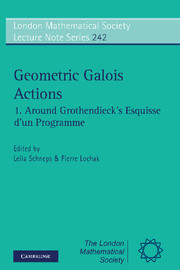Book contents
- Frontmatter
- Contents
- Preface
- ESQUISSE D'UN PROGRAMME
- Esquisse d'un Programme
- Brief an G. Faltings
- Grothendieck's “Long March through Galois theory”
- The algebraic fundamental group
- Etale homotopy type of the moduli spaces of algebraic curves
- The ‘obvious’ part of Belyi's theorem and Riemann surfaces with many automorphisms
- Glimpses of Grothendieck's anabelian geometry
- Some illustrative examples for anabelian geometry in high dimensions
- The fundamental groups at infinity of the moduli spaces of curves
- Galois representations in the profinite Teichmüller modular groups
- Deux lettres sur la cohomologie non abélienne
- The Grothendieck-Teichmüller group GT: a survey
- Approximating Galois orbits of dessins
- Tame and stratified objects
- Sketch of a Programme (translation into English)
- Letter to G. Faltings (translation into English)
Grothendieck's “Long March through Galois theory”
Published online by Cambridge University Press: 05 April 2013
- Frontmatter
- Contents
- Preface
- ESQUISSE D'UN PROGRAMME
- Esquisse d'un Programme
- Brief an G. Faltings
- Grothendieck's “Long March through Galois theory”
- The algebraic fundamental group
- Etale homotopy type of the moduli spaces of algebraic curves
- The ‘obvious’ part of Belyi's theorem and Riemann surfaces with many automorphisms
- Glimpses of Grothendieck's anabelian geometry
- Some illustrative examples for anabelian geometry in high dimensions
- The fundamental groups at infinity of the moduli spaces of curves
- Galois representations in the profinite Teichmüller modular groups
- Deux lettres sur la cohomologie non abélienne
- The Grothendieck-Teichmüller group GT: a survey
- Approximating Galois orbits of dessins
- Tame and stratified objects
- Sketch of a Programme (translation into English)
- Letter to G. Faltings (translation into English)
Summary
Note. This short text was originally written as a contribution to the “Grothendieck day” which took place in Utrecht on April 12, 1996. It is brief and informal, and was intended to give the audience some very partial idea of what is contained in Grothendieck's long manuscript “La Longue Marche à travers la Théorie de Galois”. The close connections between the ideas expressed there and those in parts of the Esquisse and the letter to Faltings in this volume make it relevant to publish it here.
Alexander Grothendieck wrote the Long March between January and June 1981. It consists of about 1600 manuscript pages, and nearly as much again in various addenda and developments. About the first 600 pages, consisting of §§1-37, have been read and edited; the main body of the Long March consists of §§1-53. From the table of contents of §§38-53, it seems that they are mainly devoted to the close study of the ideas expressed in the first part, in the cases where (g, n) = (0,3) and (1,1). In 1984, Grothendieck wrote and distributed the Esquisse d'un Programme, a 57-page text part of which summarizes, sometimes in a more advanced form, the main themes and problems considered in the Long March. Both texts are devoted to raising deep questions and examining various approaches to them, and contain few explicit theorems.
- Type
- Chapter
- Information
- Geometric Galois Actions , pp. 59 - 66Publisher: Cambridge University PressPrint publication year: 1997



